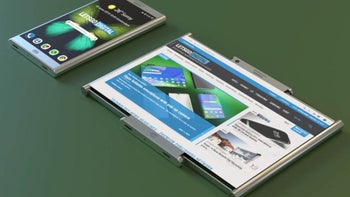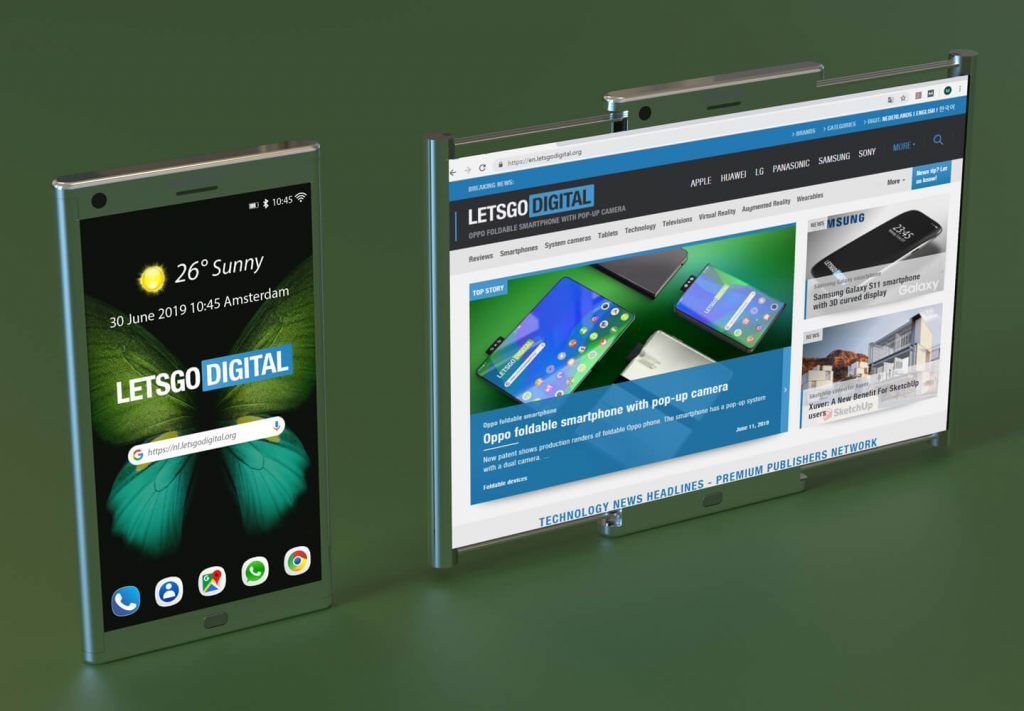Samsung receives a patent for a phone that expands to become a tablet

With the Samsung Galaxy Fold in limbo at the moment, the foldable handset is far from the most ambitious smartphone design that Samsung has been thinking about creating. Last month, a patent received by the South Korean manufacturer revealed a phone that adds screen space and extends the size of the display by rolling out the additional real estate when needed. We are still years away from seeing something like this hit the market.
Another patent received last month by Samsung was just published by the U.S. Patent and Trademark Office (USPTO). Spotted by LetsGo Digital, the patent covers a phone that is pulled from each side; when this is done, more screen real estate rolls out from the side casing turning the phone into a tablet. The screen can expand up to 3 times its size when it is converted from a phone to a tablet, relying on a motorized "rolling mechanism" to roll out the screen and roll it back into the casing. The frame edges can be used as a grip and the flexible screen moves on rails which helps support it. When the device is closed and reverts back to phone size, there are slots that come together to make the unit solid and stable.
Samsung showed off a prototype retractable screen in 2016
The patent is titled "Display Device" and the implementation of the device seen in the patent will need much more work in real life to see if such a product can be made. Besides requiring a type of smartphone display that has yet to be mass produced, the housing is too thin to contain any type of battery (which also explains the lack of a 3.5mm earphone jack on the sketches that accompany the patent). And there is also the possibility that some dust or debris can sneak its way into the mechanical parts of the product and gum up the work. In fact, that was one of the issues that forced Samsung to delay the launch of the Galaxy Fold. One influencer had dirt or dust enter the device through a gap on the top or bottom of the hinge; this debris left a bulge on the internal screen. Samsung has reportedly made the gaps on the hinge smaller to prevent this situation from repeating.

Render from LetsGo Digital based on the sketches that accompanied the patent
Back in 2016, Samsung showed off a prototype rollable display that appears to be somewhat similar to the device that it shows in the patent. When fully extended that AMOLED screen measures 5.7-inches and features a 1080p FHD resolution. While the prototype display is only 0.3mm thick, that doesn't include the additional layer required to make it a touchscreen.


The foldable segment of the smartphone market was kicked off when the Royale FlexPai was unveiled last year. But the real fireworks were supposed to start on April 26th when the Samsung Galaxy Fold was scheduled to be released. However, just days before the launch Samsung halted the fesitivities after several influencers failed to heed a warning from Samsung and damaged their review units by peeling off what they thought was a protective film on the internal screen. Other issues were also discovered and Samsung has reportedly been working to correct all of them. Pre-orders taken by AT&T and Best Buy were canceled. Unless told explicitly by its customers, Samsung also rescinded reservations for the foldable phone. We might not see Samsung release the Galaxy Fold until August at the earliest. And the foldable Huawei Mate X, originally expected this summer, has been delayed until September.










Things that are NOT allowed: